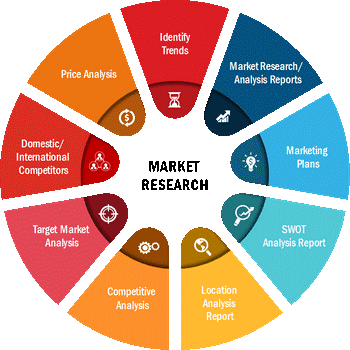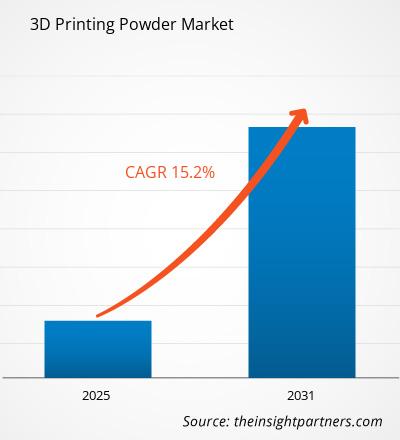3D打印粉末市场预计将从2022年的11.1亿美元增长到2031年的26.1亿美元;预计 2022 年至 2031 年复合年增长率为 15.2%。
在 3D 打印或增材制造中,打印机使用材料粉末。粉末状非晶材料用作创建 3D 物体的墨水。 3D 打印过程是通过沉积一层精细粉末来完成的,并基于选定的设计横截面并通过激光曝光机,颗粒在激光曝光机中熔化并烧结在一起。 3D 打印可以通过多种方式完成,其中熔融沉积成型 (FDM) 是最常见的。工程师和制造商依靠选择性激光烧结 (SLS) 3D 打印来制造耐用且功能齐全的物品。 3D打印粉末的成长市场归因于汽车、航空航天、国防、医疗保健、牙科和消费品等各个领域采用 3D 打印粉末的增加。
市场动态
对 3D 打印卓越增材制造技术的需求不断增长,是推动 3D 打印粉末需求增加的主要原因,这反过来又推动了市场增长。此外,汽车和汽车行业的应用不断增加。航空航天领域和医疗领域不断增长的需求也推动了3D打印粉末市场的增长。 3D打印粉末在汽车领域的涡轮增压器中得到应用、外壳和支架、轮胎模具、传动板、控制阀和泵、冷却通风口、仪表板、座椅框架原型、保险杠、车身面板和其他发动机部件。此外,i快速原型制作,航空航天业需求的增长以及发展中地区汽车技术的进步正在推动预测期内对3D打印粉末市场的需求。
市场范围
“全球3D打印粉末市场到2031年的预测”报告旨在提供市场概述和详细的市场细分。它提供了基于领先市场参与者表现的关键统计数据,并提供了主要趋势以及市场机会。
战略见解
市场细分
全球3D打印粉末市场根据类型和应用分为两部分。根据类型,市场分为金属、塑料、陶瓷等。根据应用,市场分为航空航天和国防、汽车、医疗等。
全球3D打印粉末市场分为北美、欧洲、亚太地区 (APAC)、中东和非洲 (MEA) 以及南美洲和中美洲五个主要区域。该报告涵盖了 18 个国家的分析和预测世界各国,以及这些地区的流行趋势和机遇。
北美主导3D打印粉末2021 年市场。北美技术先进的初创企业和政府机构对 3D 打印行业的投资增加,预计将在预测期内推动市场增长。此外,< a title="3D打印市场" href="https://www.theinsightpartners.com/zh-CN/reports/3d-printing-market" target="_blank" rel="noopener">3D打印市场也有可能增强3D打印粉末市场此外,开发成本的下降将导致粉末基3D打印的可用性上升。此外,耐用消费品、配件和装饰品等其他应用预计也将增加对粉末3D打印的需求。 3D打印粉末。
来源:Insight Partners 分析
市场。它还对影响这些地区市场的因素进行了详尽的波特五力分析。
COVID-19 大流行的影响
COVID-19大流行严重影响了许多行业。封锁的实施暂时停止了各种制造活动,导致原材料供应减少,这对3D打印粉末市场产生了负面影响。市场的最终-从航空航天、石油天然气到医疗等用户行业都因疫情而受到阻碍。但为了克服医疗设备和防护服的短缺,许多国家采用了3D打印产品。 例如,2021 年 9 月,美国食品和药物管理局开始与 NIH、VA 和 America Makes 合作,支持 3D 打印等非传统制造方法。低成本桌面 3D 打印机允许经济的 3D 模型和指南,但质量认证较少。
为了检测早期的SARS-CoV-2感染,鼻咽拭子是采集鼻上皮粘膜进行检测的重要设备。疫情期间,鼻咽拭子的需求量难以预测借助3D打印实现新型拭子的量产,此外,美国政府批准使用3D打印技术制造医疗设备和安全套件,预计制药行业对3D打印粉末的需求增加预测期内3D打印粉末市场的增长。
市场参与者
各种公司都专注于有机增长战略,例如产品发布、产品批准、专利和活动。收购、伙伴关系和协作是市场上见证的无机增长战略活动之一。这些活动为市场参与者的业务扩展和客户群铺平了道路。由于对 3D 打印粉末的需求不断增长,预计市场参与者将在未来几年经历利润丰厚的增长机会。
该报告包括从事 3D 打印粉末业务的主要公司简介市场,以及他们的 SWOT 分析和市场策略。它还重点关注行业领先企业的信息,例如公司简介、提供的组件和服务、过去三年的财务信息以及过去五年的重点发展。
< p>3D打印粉末行业重点经营企业市场- 日本气体
- Erasteel < li style="color: rgb(33, 37, 41); 行高: 正常; 背景: 白色; 上边距: 0cm; 右边距: 0cm; 下边距: 8pt; 字体大小: 10pt; 字体-family: verdana、geneva、sans-serif;">斯坦福先进材料
- Höganäs AB
- 吉凯恩烧结金属工程有限公司
- 短信集团有限公司
- Astro 合金公司
- 赢创工业股份公司
- 山特维克 AB
- Markforged
Insight Partner 的专业研究和分析团队由经验丰富的专业人士组成,拥有先进的统计专业知识,并在现有研究中提供各种定制选项。

- 历史分析(2 年)、基准年、预测(7 年)及复合年增长率
- PEST 和 SWOT 分析
- 市场规模价值/数量 - 全球、区域、国家
- 行业和竞争格局
- Excel 数据集



Report Coverage
Revenue forecast, Company Analysis, Industry landscape, Growth factors, and Trends

Segment Covered
This text is related
to segments covered.

Regional Scope
North America, Europe, Asia Pacific, Middle East & Africa, South & Central America

Country Scope
This text is related
to country scope.
Trends and growth analysis reports related to Chemicals and Materials : READ MORE..
The List of Companies
1. Sandvik AB
2. CRS Holdings Inc
3. GENERAL ELECTRIC
4. ERASTEEL
5. EOS
6. Arkema
7. ExOne
8. Höganäs AB
9. GKN Sinter Metals Engineering GmbH
10. SMS group GmbH
11. Astro Alloys Inc
12. Stanford Advanced Materials
13. Metalysis
14. BASF SE
15. Evonik
16. voestalpine High Performance Metals Corp
17. Xi'an Sailong Metal Materials Co., Ltd.
18. Metal Technology Co. Ltd.
19. Markforged
20.PROTIQ
The Insight Partners performs research in 4 major stages: Data Collection & Secondary Research, Primary Research, Data Analysis and Data Triangulation & Final Review.
- Data Collection and Secondary Research:
As a market research and consulting firm operating from a decade, we have published and advised several client across the globe. First step for any study will start with an assessment of currently available data and insights from existing reports. Further, historical and current market information is collected from Investor Presentations, Annual Reports, SEC Filings, etc., and other information related to company’s performance and market positioning are gathered from Paid Databases (Factiva, Hoovers, and Reuters) and various other publications available in public domain.
Several associations trade associates, technical forums, institutes, societies and organization are accessed to gain technical as well as market related insights through their publications such as research papers, blogs and press releases related to the studies are referred to get cues about the market. Further, white papers, journals, magazines, and other news articles published in last 3 years are scrutinized and analyzed to understand the current market trends.
- Primary Research:
The primarily interview analysis comprise of data obtained from industry participants interview and answers to survey questions gathered by in-house primary team.
For primary research, interviews are conducted with industry experts/CEOs/Marketing Managers/VPs/Subject Matter Experts from both demand and supply side to get a 360-degree view of the market. The primary team conducts several interviews based on the complexity of the markets to understand the various market trends and dynamics which makes research more credible and precise.
A typical research interview fulfils the following functions:
- Provides first-hand information on the market size, market trends, growth trends, competitive landscape, and outlook
- Validates and strengthens in-house secondary research findings
- Develops the analysis team’s expertise and market understanding
Primary research involves email interactions and telephone interviews for each market, category, segment, and sub-segment across geographies. The participants who typically take part in such a process include, but are not limited to:
- Industry participants: VPs, business development managers, market intelligence managers and national sales managers
- Outside experts: Valuation experts, research analysts and key opinion leaders specializing in the electronics and semiconductor industry.
Below is the breakup of our primary respondents by company, designation, and region:

Once we receive the confirmation from primary research sources or primary respondents, we finalize the base year market estimation and forecast the data as per the macroeconomic and microeconomic factors assessed during data collection.
- Data Analysis:
Once data is validated through both secondary as well as primary respondents, we finalize the market estimations by hypothesis formulation and factor analysis at regional and country level.
- Macro-Economic Factor Analysis:
We analyse macroeconomic indicators such the gross domestic product (GDP), increase in the demand for goods and services across industries, technological advancement, regional economic growth, governmental policies, the influence of COVID-19, PEST analysis, and other aspects. This analysis aids in setting benchmarks for various nations/regions and approximating market splits. Additionally, the general trend of the aforementioned components aid in determining the market's development possibilities.
- Country Level Data:
Various factors that are especially aligned to the country are taken into account to determine the market size for a certain area and country, including the presence of vendors, such as headquarters and offices, the country's GDP, demand patterns, and industry growth. To comprehend the market dynamics for the nation, a number of growth variables, inhibitors, application areas, and current market trends are researched. The aforementioned elements aid in determining the country's overall market's growth potential.
- Company Profile:
The “Table of Contents” is formulated by listing and analyzing more than 25 - 30 companies operating in the market ecosystem across geographies. However, we profile only 10 companies as a standard practice in our syndicate reports. These 10 companies comprise leading, emerging, and regional players. Nonetheless, our analysis is not restricted to the 10 listed companies, we also analyze other companies present in the market to develop a holistic view and understand the prevailing trends. The “Company Profiles” section in the report covers key facts, business description, products & services, financial information, SWOT analysis, and key developments. The financial information presented is extracted from the annual reports and official documents of the publicly listed companies. Upon collecting the information for the sections of respective companies, we verify them via various primary sources and then compile the data in respective company profiles. The company level information helps us in deriving the base number as well as in forecasting the market size.
- Developing Base Number:
Aggregation of sales statistics (2020-2022) and macro-economic factor, and other secondary and primary research insights are utilized to arrive at base number and related market shares for 2022. The data gaps are identified in this step and relevant market data is analyzed, collected from paid primary interviews or databases. On finalizing the base year market size, forecasts are developed on the basis of macro-economic, industry and market growth factors and company level analysis.
- Data Triangulation and Final Review:
The market findings and base year market size calculations are validated from supply as well as demand side. Demand side validations are based on macro-economic factor analysis and benchmarks for respective regions and countries. In case of supply side validations, revenues of major companies are estimated (in case not available) based on industry benchmark, approximate number of employees, product portfolio, and primary interviews revenues are gathered. Further revenue from target product/service segment is assessed to avoid overshooting of market statistics. In case of heavy deviations between supply and demand side values, all thes steps are repeated to achieve synchronization.
We follow an iterative model, wherein we share our research findings with Subject Matter Experts (SME’s) and Key Opinion Leaders (KOLs) until consensus view of the market is not formulated – this model negates any drastic deviation in the opinions of experts. Only validated and universally acceptable research findings are quoted in our reports.
We have important check points that we use to validate our research findings – which we call – data triangulation, where we validate the information, we generate from secondary sources with primary interviews and then we re-validate with our internal data bases and Subject matter experts. This comprehensive model enables us to deliver high quality, reliable data in shortest possible time.

 获取此报告的免费样本
获取此报告的免费样本